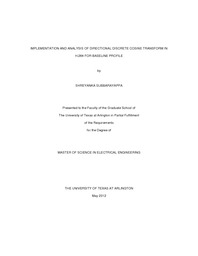
ATTENTION: The works hosted here are being migrated to a new repository that will consolidate resources, improve discoverability, and better show UTA's research impact on the global community. We will update authors as the migration progresses. Please see MavMatrix for more information.
Show simple item record
| dc.contributor.author | Subbarayappa, Shreyanka | en_US |
| dc.date.accessioned | 2012-07-25T19:22:38Z | |
| dc.date.available | 2012-07-25T19:22:38Z | |
| dc.date.issued | 2012-07-25 | |
| dc.date.submitted | January 2012 | en_US |
| dc.identifier.other | DISS-11606 | en_US |
| dc.identifier.uri | http://hdl.handle.net/10106/11146 | |
| dc.description.abstract | H.264/AVC [1] is a video coding standard that has a wide range of applications ranging from high-end professional camera and editing systems to low-end mobile applications. They strive to achieve maximum compression efficiency without compromising the quality of video. To this end many coding tools are defined in the coder. Transform coding is one among them. Transform Coding represents the signal/image (that is currently in time/spatial domain) in another domain (transform domain), where most of the energy of the signal/image is concentrated in a fewer number of coefficients. Thus the insignificant coefficients can be discarded after transform coding to achieve compression. In images/videos, the DCT-II [2][3] (which represents a signal/image as the weighted sum of cosine functions with different frequencies) is primarily used for transform coding [2]. Nearly all block-based transform schemes for image and video coding developed so far choose the 2-D discrete cosine transform (DCT) [2] of a square block shape. With almost no exception, this conventional DCT is implemented separately through two 1-D transforms [2], one along the vertical direction and another along the horizontal direction. Developing a new block based DCT framework is one in which the first transform may choose to follow a direction other than the vertical or horizontal one (directional one) and the second transform chooses the horizontal one. The coefficients produced by all the directional transforms in the first step are arranged appropriately so that the second transform can be applied to the coefficients that are best aligned with one another. Compared with the conventional DCT, the resulting directional DCT [4] framework is able to provide a better coding performance for image blocks that contain directional edges - a popular scenario in many image signals. By choosing the best from all directional DCTs (including the conventional DCT as a special case) for each image block, the rate distortion coding performance can be improved remarkably. | en_US |
| dc.description.sponsorship | Rao, Kamisetty R. | en_US |
| dc.language.iso | en | en_US |
| dc.publisher | Electrical Engineering | en_US |
| dc.title | Implementation And Analysis Of Directional Discrete Cosine Transform In H.264 For Baseline Profile | en_US |
| dc.type | M.S. | en_US |
| dc.contributor.committeeChair | Rao, Kamisetty R. | en_US |
| dc.degree.department | Electrical Engineering | en_US |
| dc.degree.discipline | Electrical Engineering | en_US |
| dc.degree.grantor | University of Texas at Arlington | en_US |
| dc.degree.level | masters | en_US |
| dc.degree.name | M.S. | en_US |
Files in this item
- Name:
- Subbarayappa_uta_2502M_11606.pdf
- Size:
- 1.827Mb
- Format:
- PDF
This item appears in the following Collection(s)
Show simple item record


